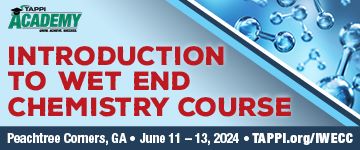 Search
Search
Use the search bar or filters below to find any TAPPI product or publication.
Filters
Content Type
Publications
Level of Knowledge
Collections
Magazine articles

The role of science in setting the environmental agenda, TAPPI JOURNAL, September 2000, Vol. 83(9)
The role of science in setting the environmental agenda, TAPPI JOURNAL, September 2000, Vol. 83(9)
Magazine articles

The global wood fiber equation - a new world order?, TAPPI JOURNAL, January 1996, Vol. 79(1)
The global wood fiber equation - a new world order?, TAPPI JOURNAL, January 1996, Vol. 79(1)
Magazine articles

English as a first and second language - part 7: a strategy for spelling, TAPPI JOURNAL, October 1998, Vol.81(10)
English as a first and second language - part 7: a strategy for spelling, TAPPI JOURNAL, October 1998, Vol.81(10)
Magazine articles

The r & t system: everyone is responsible for innovation, TAPPI JOURNAL, September 2000, Vol. 83(9)
The r & t system: everyone is responsible for innovation, TAPPI JOURNAL, September 2000, Vol. 83(9)
Journal articles

Magazine articles

Economic and competitive potential of lignin-based thermoplastics using a multicriteria decision-making method, TAPPI Journal September 2022
ABSTRACT: As a result of new lignin extraction plants hatching and increasing volumes of technical lignin becoming available, a variety of lignin derivatives, including phenolic resins and polyurethane (PU) foams, are reaching the marketplace or being used as intermediate products in many industrial applications. In the spectrum of possible lignin derivatives, thermoplastics appear particularly attractive due to a symbiosis of market, policy, and technology drivers. To assess the preferredness for lignin-based thermoplastics, this paper adapted a risk-oriented methodology formerly applied to assess lignin usage in various applications (phenol-formaldehyde [PF] resins, PU foams, and carbon fiber applications) to the case of lignin-based thermoplastics using hydroxypropylated lignin (HPL) and miscible blends of lignin and polyethylene oxide (PEO). The HPL is considered for garbage bags and agricultural films applications, while lignin-PEO blends are used as replacement for acrylonitrile butadiene styrene (ABS) in applications such as automotive parts. In the methodology, two phased-implementation strategies were defined for each thermoplastic derivative, considering perspectives for profit maximization (90 metric tons/day integrated units) and revenue growth (350 metric tons/day overall capacity), which were considered for implementation within a softwood kraft pulping mill. A set of six criteria representative of the main economic and market competitiveness issues were employed, and their respective importance weights were obtained in a multicriteria decision-making (MCDM) panel.Early-stage techno-economic estimates were done as a basis for the calculation of decision criteria. Compared to product derivatives previously assessed, capital investment for thermoplastic strategies appeared marginally higher due to the required lignin modification steps (on average 30% higher at similar capacity, and 6% for higher-scale revenue diversification strategies). Higher operating costs were also observed due to increased chemical expenses for all thermoplastic strategies, which are ultimately balanced by revenues associated with targeted thermoplastic products, leading to greater annual margins and cash flow generation over the project lifetime for thermoplastic strategies compared to other product applications (58% to 66% higher on average, at similar scale). Benefits of improved economics were reflected in economic criteria, internal rate of return (IRR), and cash flow on capital employed (CFCE), as well as in the price competitiveness criterion, CPC. Overall, the combination of relatively high lignin content in the plastic formulation and the less costly modification method contributed to lignin-PEO strategies, gaining the top two rankings. Based on their overall scores, both strategies defined for HPL would also integrate the group of “preferred” strategies, but are outranked by strategies that consider lignin positioning on PU foam applications.
Magazine articles

Modern management, technology, make skogn significant newsprint maker, TAPPI JOURNAL, March 1991, Vol. 74(3)
Modern management, technology, make skogn significant newsprint maker, TAPPI JOURNAL, March 1991, Vol. 74(3)
Magazine articles

Alkaline peroxide mechanical pulping of hardwoods, TAPPI JOURNAL, June 1991, Vol. 74(6)
Alkaline peroxide mechanical pulping of hardwoods, TAPPI JOURNAL, June 1991, Vol. 74(6)
Magazine articles

Operations teams run a woodyard, TAPPI JOURNAL, December 1996, Vol. 79(12)
Operations teams run a woodyard, TAPPI JOURNAL, December 1996, Vol. 79(12)
Magazine articles

Local section development efforts earn distinction for paul magnabosco, TAPPI JOURNAL, March 1996, Vol. 79(3)
Local section development efforts earn distinction for paul magnabosco, TAPPI JOURNAL, March 1996, Vol. 79(3)
Magazine articles

Shop talk: reducing voc emissions with thermal oxidation units, TAPPI JOURNAL, December 1997, Vol. 80(12)
Shop talk: reducing voc emissions with thermal oxidation units, TAPPI JOURNAL, December 1997, Vol. 80(12)






